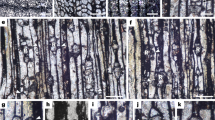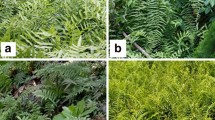Abstract
Our knowledge of the evolution of vascular tissue through geologic time has come almost entirely from xylem; no doubt due to the fact that thick-walled tracheids are more easily preserved in depositional environments. As a result, secondary xylem is common in the fossil record from the Devonian to the Recent. In contrast, phloem tissue consists of relatively thin-walled cells that are less likely to be preserved. Conducting elements in the phloem are under high hydrostatic pressure while they are functioning and this physiological constraint probably contributes to their collapse during fossilization and their subsequent rarity in the geologic record. Within the past 10 years, however, there have been a number of contributions that have focused on the anatomy of phloem in fossil plants (Table 14.1) and the data from these studies are beginning to provide a picture of phloem structure and evolution through geologic time.
Formerly Edith L. Smoot.
Access this chapter
Tax calculation will be finalised at checkout
Purchases are for personal use only
Preview
Unable to display preview. Download preview PDF.
Similar content being viewed by others
References
Arnold CA (1930) Bark structure of Callixylon. Bot Gaz: 427–431.
Bailey IW (1953) Evolution of the tracheary tissue of land plants. Am J Bot 40: 4–8.
Banks HP, Leclercq S, Hueber FM (1975) Anatomy and morphology of Psilophyton dawsonii, sp. n. from the late Lower Devonian of Quebec (Gaspé), and Ontario, Canada. Palaeontogr Am 8: 77–127.
Baxter RW (1964) Paleozoic starch in fossil seeds from Kansas coal balls. Trans Kansas Acad Sci 67: 418–422.
Behnke H-D (1986) Sieve element characters and the systematic position of Austrobaileya, Austrobaileyaceae — with comments to the distinction and definition of sieve cells and sieve-tube members. Plant Syst Evol 152:101–121.
Carlquist S (1975) Ecological strategies of xylem evolution. Univ Cal Press, Berkeley.
Cheadle VI (1948) Observations on the phloem in the Monocotyledoneae. II. Additional data on the occurrence and phylogenetic specialization in structure of the sieve tubes in the metaphloem. Am J Bot 35: 129–131.
Cheadle VI, Whitford NB (1941) Observations on the phloem in the Monocotyledoneae. I. The occurrence and phylogenetic specialization in structure of the sieve tubes in the metaphloem. Am J Bot 28: 623–627.
Cichan MA (1986) Vascular cambium and wood development in Carboniferous plants. III. Arthropitys (Equisetales; Calamitaceae). Can J Bot 64: 688–695.
Cichan MA, Taylor TN (1990) Evolution of cambium in geologic time — a reappraisal. In: Iqbal M (ed) The vascular cambium. Research Studies Press, Taunton (England), (in press).
Delrot S (1987) Phloem loading: apoplastic or symplastic? Plant Physiol Biochem 25: 667–676.
Eggert DA, Gaunt DD (1973) Phloem of Sphenophyllum. Am J Bot 60: 775–770.
Eggert DA, Kanemoto NY (1977) Stem phloem of a Middle Pennsylvanian Lepidodendron. Bot Gaz 138: 102–111.
Esau K (1969) The phloem. In: Zimmermann W, Ozenda P, Wulff HD (eds) Encyclopedia of plant anatomy, vol 5, pt. 2. Borntraeger, Berlin Stuttgart, 505 pp.
Esau K, Cheadle VI, Gifford EM (1953) Comparative structure and possible trends of specialization of the phloem. Am J Bot 40: 9–19.
Galtier J, Hébant C (1973) Sur le phloème et le cambium d’une Calamopityacée, ptéridospermale probable du Carbonifère inférieur franėais. C R Acad Sci Paris Ser D 276: 2257–2259.
Gillespie WH, Rothwell GW, Scheckler SE (1981) The earliest seeds. Nature (London) 293:462–464.
Hall JW (1952) The phloem of Heterangium americanum. Am Midl Nat 47: 763–768.
Joy KW, Willis AJ, Lacey WS (1956) A rapid cellulose peel technique in palaeobotany. Ann Bot (London) 20: 635–637.
Kidston R, Lang WH (1917) On Old Red Sandstone plants showing structure, from the Rhynie chert bed, Aberdeenshire, pt 1. Rhynia Gwynne-Vaughani, Kidston and Lang. Trans R Soc Edinburgh 51: 761–784.
Kidston R, Lang WH (1920) On Old Red Sandstone plants showing structure, from the Rhynie chert bed, Aberdeenshire, pt 2. Additional notes on Rhynia Gwynne-Vaughani, Kidston and Lang; with descriptions of Rhynia major, n. sp., and Hornea Lignieri, n. g., n. sp. Trans R Soc Edinburgh 52: 603–627.
Kruatrachue M, Evert RF (1974) Structure and development of sieve elements in the leaf of Isoetes muricata. Am J Bot 61: 253–266.
Minchin PEH, Thorpe MR (1987) Is phloem transport due to a hydrostatic pressure gradient? Supporting evidence from pressure chamber experiments. Aust J Plant Physiol 14: 397–402.
Niklas KJ, Brown RM, Santos R, Vian B (1978) Ultrastructure and cytochemistry of Miocene angiosperm leaf tissues. Proc Natl Acad Sci USA 75: 3263–3267.
Outer RW den (1967) Histological investigations of the secondary phloem in gymnosperms. Meded Landbouwh Wageningen 67(7): 1–119.
Perry JW, Evert RF (1975) Structure and development of the sieve elements in Psilotum nudum. Am J Bot 62: 1038–1052.
Ramanujam CGK (1970) A petrified bark of Cupressaceae from the Cretaceous of Alberta. Can J Bot 48:; 855–858.
Ramanujam CGK, Stewart WN (1969) Taxodiaceous bark from the Upper Cretaceous of Alberta. Am J Bot 56:101–107.
Russin WA (1981) Secondary phloem of the Paleozoic pteridosperm Callistophyton boyssetii (Renault) Rothwell. Bot Gaz 142: 165–175.
Smoot EL (1979) The phloem of Etapteris leclercqii and Botryopteris tridentata. Am J Bot 66:511–521.
Smoot EL (1984a) Secondary phloem anatomy in Callistophyton boyssetii (Renault) Rothwell and histological changes in the outer phloem. Bot Gaz 145: 295–406.
Smoot EL (1984b) Phloem anatomy of the Carboniferous pteridosperm Medullosa and evolutionary trends in gymnosperm phloem. Bot Gaz 145: 550–564.
Smoot EL (1984c) Phloem structure in the Carboniferous fern Psaronius (Marattiales). Am J Bot 71:1104–1113.
Smoot EL (1985) Phloem anatomy of the Carboniferous coenopterid ferns Anachoropteris and Ankyropteris. Am J Bot 72: 191–208.
Smoot EL, Taylor TN (1978) Sieve areas in fossil phloem. Science 202: 1081–1083.
Smoot EL, Taylor TN (1981) Phloem histology of a Lower Pennsylvanian Psaronius. Palaeobotanist 28-29: 81–85.
Smoot EL, Vande Wege M (1986) Phloem anatomy in Staumpteris biseriata from the Pennsylvanian of North America. Am J Bot 73: 1043–1048.
Stewart WN (1940) Phloem histology in stigmarian appendages. Trans Ill State Acad Sci 33:54–57.
Stewart WN (1947) A comparative study of stigmarian appendages and Isoetes roots. Am J Bot 34:315–324.
Stidd BM, Ma P (1978) Does Sphenophyllum have sieve tubes? Bot Soc Am Misc Ser Publ 156:59.
Taylor EL (1987) Fossil phloem tissue: evidence for evolutionary conservatism. Am J Bot 74:690–691.
Taylor EL (1988a) Secondary phloem anatomy in Cordaitean axes. Am J Bot 75:1655–1666.
Taylor EL (1988b) Secondary phloem anatomy in Cycadeoidea. Am J Bot 75 (6, pt 2): 118.
Taylor EL, Taylor TN (1990) Phloem anatomy in fossil plants. In: Iqbal M (ed) Growth patterns in vascular plants. Dioscorides Press, Portland (Oregon), (in press).
Warmbrodt RD (1980) Characteristics of structure and differentiation in the sieve element of lower vascular plants. Ber Dtsch Bot Ges 93:13–28.
Wight DC, Beck CB (1984) Sieve cells in phloem of a Middle Devonian progymnosperm. Science 225:1469–1471.
Wilson MA, Eggert DA (1974) Root phloem of fossil tree-sized arthrophytes. Bot Gaz 135:319–328.
Zahur MS (1959) Comparative study of secondary phloem of 423 species of woody dicotyledons belonging to 85 families. Cornell Univ Agric Exp Stn Mem 358:1–160.
Editor information
Editors and Affiliations
Additional information
Dedicated to Katherine Esau for her inspiring work on phloem structure
Rights and permissions
Copyright information
© 1990 Springer-Verlag Berlin Heidelberg
About this chapter
Cite this chapter
Taylor, E.L. (1990). Phloem Evolution: An Appraisal Based on the Fossil Record. In: Behnke, HD., Sjolund, R.D. (eds) Sieve Elements. Springer, Berlin, Heidelberg. https://doi.org/10.1007/978-3-642-74445-7_14
Download citation
DOI: https://doi.org/10.1007/978-3-642-74445-7_14
Publisher Name: Springer, Berlin, Heidelberg
Print ISBN: 978-3-642-74447-1
Online ISBN: 978-3-642-74445-7
eBook Packages: Springer Book Archive




